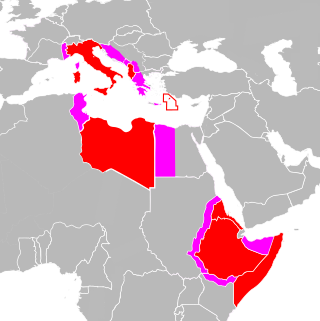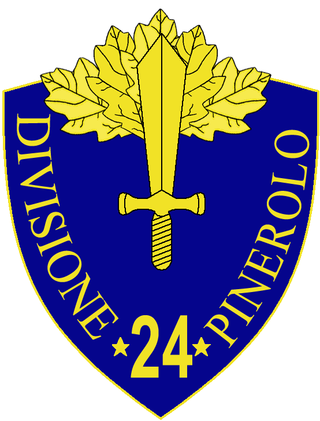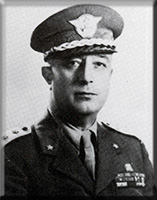
The Axis powers, originally called the Rome–Berlin Axis and also Rome–Berlin–Tokyo Axis, was a military coalition that initiated World War II and fought against the Allies. Its principal members were Nazi Germany, Fascist Italy and the Empire of Japan. The Axis were united in their far-right positions and general opposition to the Allies, but otherwise lacked comparable coordination and ideological cohesion.

The participation of Italy in the Second World War was characterized by a complex framework of ideology, politics, and diplomacy, while its military actions were often heavily influenced by external factors. Italy joined the war as one of the Axis Powers in 1940 with a plan to concentrate Italian forces on a major offensive against the British Empire in Africa and the Middle East, known as the "parallel war", while expecting the collapse of British forces in the European theatre. The Italians bombed Mandatory Palestine, invaded Egypt and occupied British Somaliland with initial success. However, the British counterattacked, eventually necessitating German support to prevent an Italian collapse in North Africa. As the war carried on and German and Japanese actions in 1941 led to the entry of the Soviet Union and United States, respectively, into the war, the Italian plan of forcing Britain to agree to a negotiated peace settlement was foiled.
The Kingdom of Romania, under the rule of King Carol II, was initially a neutral country in World War II. However, Fascist political forces, especially the Iron Guard, rose in popularity and power, urging an alliance with Nazi Germany and its allies. As the military fortunes of Romania's two main guarantors of territorial integrity—France and Britain—crumbled in the Fall of France, the government of Romania turned to Germany in hopes of a similar guarantee, unaware that Germany, in the supplementary protocol to the 1939 Molotov–Ribbentrop Pact, had already granted its blessing to Soviet claims on Romanian territory.

Almost every country in the world participated in World War II. Most were neutral at the beginning, but only a relative few nations remained neutral to the end. The Second World War pitted two alliances against each other, the Axis powers and the Allied powers. It is estimated that 74 million people died, with estimates ranging from 40 million to 90 million dead. The main Axis powers were Nazi Germany, the Empire of Japan, and the Kingdom of Italy; while the United Kingdom, the United States, the Soviet Union and China were the "Big Four" Allied powers.

The Mediterranean and Middle East Theatre was a major theatre of operations during the Second World War. The vast size of the Mediterranean and Middle East theatre saw interconnected naval, land, and air campaigns fought for control of the Mediterranean, North Africa, the Horn of Africa, the Middle East and Southern Europe. The fighting lasted from 10 June 1940, when Italy declared war on United Kingdom and France, until 2 May 1945 when all Axis forces in Italy surrendered. However, fighting would continue in Greece – where British troops had been dispatched to aid the Greek government – during the early stages of the Greek Civil War.

The Allies, formally referred to as the United Nations from 1942, were an international military coalition formed during World War II (1939–1945) to oppose the Axis powers. Its principal members by the end of 1941 were the "Big Four" – the United Kingdom, United States, Soviet Union, and China.

The P 26/40 was an Italian World War II heavy tank. It was armed with a 75 mm gun and an 8 mm Breda machine gun, plus another optional machine gun in an anti-aircraft mount. Design had started in 1940 but very few had been built by the time Italy signed the armistice with the Allies in September 1943 and the few produced afterwards were used by the Germans.

Tanks were an important weapons system in World War II. Although tanks in the inter-war years were the subject of widespread research, few were made, in just a few countries. However, during World War II, most armies employed tanks, and thousands were built every month. Tank usage, doctrine, and production varied widely among the combatant nations. By war's end, a consensus was forming on tank doctrine and design.

The history of Bulgaria during World War II encompasses an initial period of neutrality until 1 March 1941, a period of alliance with the Axis Powers until 8 September 1944, and a period of alignment with the Allies in the final year of the war. With German consent, Bulgarian military forces occupied parts of the Kingdoms of Greece and Yugoslavia which Bulgarian irredentism claimed on the basis of the 1878 Treaty of San Stefano. Bulgaria resisted Axis pressure to join the war against the Soviet Union, which began on 22 June 1941, but did declare war on Britain and the United States on 13 December 1941. The Red Army entered Bulgaria on 8 September 1944; Bulgaria declared war on Germany the next day.

The Gyorshadtest was the most modern and best-equipped mechanized unit of the Royal Hungarian Army at the beginning of World War II. However, the "Rapid Corps" name was something of a misnomer as it was only "mechanized" compared to other Hungarian units. The corps was not particularly mechanized when compared to similar units fielded by countries like Germany or the Soviet Union.

The Axis leaders of World War II were important political and military figures during World War II. The Axis was established with the signing of the Tripartite Pact in 1940 and pursued a strongly militarist and nationalist ideology; with a policy of anti-communism. During the early phase of the war, puppet governments were established in their occupied nations. When the war ended, many of them faced trial for war crimes. The chief leaders were Adolf Hitler of Nazi Germany, Benito Mussolini of Fascist Italy, and Hirohito of Imperial Japan. Unlike what happened with the Allies, there was never a joint meeting of the main Axis heads of government, although Mussolini and Hitler met on a regular basis.

The Royal Italian Army, participated in World War II on the side of the Axis Powers on 1940. The Royal Italian Army notably fought at the Balkans, Western Alps, North and East Africa and Russia until its defeat on 1943 by the Allies. The Royal Italian Army was then turned into the Italian Co-Belligerent Army fighting alongside the Allies while some Italian forces joined the Germans as the National Republican Army on the Italian Social Republic in Northern Italy.

The 24th Infantry Division "Pinerolo" was an infantry division of the Royal Italian Army during World War II. The division was based in Chieti, with its regiments in the Abruzzo region. The division was named for the city of Pinerolo. The division's regimental depots were shared with the 62nd Infantry Division "Marmarica", which was based in Derna in Libya and recruited its men from and trained them in Abruzzo.
The Marinefährprahm was the largest landing craft operated by the German Kriegsmarine during World War II. The MFP was used for transport, minelaying, as an escort and a gunboat in the Mediterranean, Baltic and Black Seas as well as the English Channel and Norwegian coastal waters. Originally developed for Operation Sea Lion the proposed invasion of England, the first of these ships was commissioned on 16 April 1941, with approximately 700 being completed by the end of war. Allied sources sometimes refer to this class of vessel as a "Flak Lighter" or "F-lighter".

Umberto Utili (1895–1952) was an Italian general known for his service with the Italian Co-belligerent Army in 1943–1945.
The Lancia Ro, Lancia Ro-Ro and Lancia 3Ro were 4x2 heavy trucks built by Italian manufacturer Lancia from the 1930s through the 1940s for military and civilian use. The 2-cylinder diesel Ro was produced from 1933 to 1939, the 3-cylinder diesel Ro-Ro from 1935 to 1939 and the improved 5-cylinder diesel 3Ro from 1938 to 1947.

Tanks have been employed by the military forces in Italy since their first use in World War I. They have had continued use in wars after and are still used through the modern day. The C1 Ariete is the current main battle tank of the Italian Army.

The Fiat 666 was a heavy truck produced by the Italian Fiat Veicoli Industriali.














